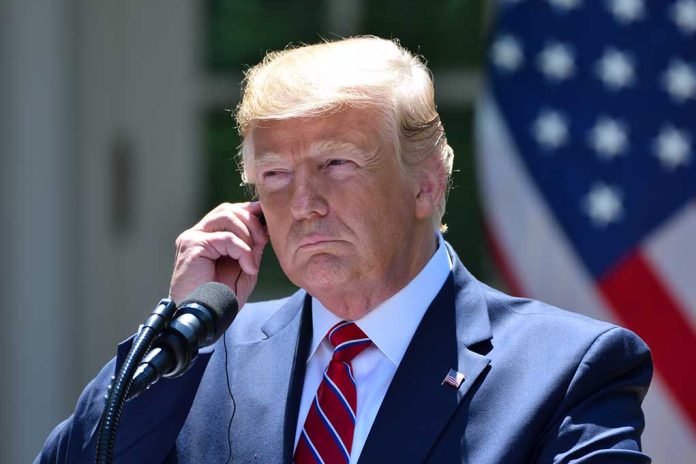
Trump’s proposed $5 million “Gold Card” visa program promises economic benefits, but the President admits he’s worried about “unsavory” applicants as questions remain about its implementation and impact on national security.
Top Takeaways
- Trump’s proposed “Gold Card” program would replace the EB-5 immigrant investor visa, offering green card privileges and a path to citizenship for $5 million per card.
- President admits he is worried about “unsavory” applicants.
- The plan aims to generate $5 trillion by selling 1 million gold cards, potentially helping pay down the national debt.
- Applicants would undergo strict vetting with provisions for refunds and deportation if “unsavory” individuals slip through.
- The proposal requires Congressional approval and faces criticism for favoring wealthy immigrants over skilled workers.
America First Through Premium Citizenship
President Donald Trump has unveiled an ambitious proposal to replace the existing EB-5 immigrant investor visa program with a new “Gold Card” system requiring a $5 million investment. During an interview on Fox News Channel’s “Ingraham Angle,” Trump outlined his vision for the program, which would offer enhanced green card privileges and a pathway to US citizenship for wealthy foreign nationals. The president suggested the initiative could generate $5 trillion by selling approximately one million of these premium visas, with proceeds directed toward reducing the national debt.
Trump defended the high price tag and exclusive nature of the program by pointing to its potential economic benefits. The current EB-5 program, established in 1990 to stimulate the US economy through foreign investment, requires investors to commit between $800,000 and $1 million while creating at least ten American jobs.
National Security Concerns and Vetting Procedures
A primary concern raised during Trump’s interview was the potential for “unsavory” individuals to exploit the program. The president acknowledged he is “worried” about this while emphasizing the robust vetting procedures that would be implemented. When questioned about the possibility of unwanted applicants, Trump outlined a straightforward approach to maintaining program integrity through comprehensive background checks and a mechanism for removing problematic participants.
The Trump administration has positioned this refund-and-deportation policy as both practical and legally sound. Commerce Secretary Howard Lutnick has been outspoken in his criticism of the current EB-5 program, describing it as “full of nonsense, make-believe and fraud.” The Gold Card proposal aims to address these shortcomings through increased financial requirements and stricter oversight measures, though implementation details remain limited.
Potential Rebranding and Legislative Hurdles
In a move that could further distinguish the program, Trump has suggested renaming it the “Trump Card” rather than the “Gold Card.” During a recent interview, he explained the marketing strategy behind this potential change, saying, “I will tell you what my people want to call it. It’ll drive you crazy. It’ll drive the left crazy. They want to call it the Trump card, because the Trump card sells much better than the gold card.”
Despite the enthusiasm from Trump’s team, the proposal faces significant legislative challenges. Since the EB-5 program was established by Congress, any substantial changes or replacements would require congressional approval. Critics, including Democratic Congressman Ro Khanna, have argued for a merit-based immigration approach focused on skilled workers rather than wealthy investors. Additionally, some immigration experts like Ashok Kumar Adusumilli have questioned whether the $5 million price tag is competitive in the global market for investor visas.
Economic Impact and Implementation Timeline
Trump has characterized the Gold Card as a “green card plus,” suggesting it would offer additional benefits beyond standard permanent residency. The economic rationale behind the program focuses on attracting high-net-worth individuals who would contribute significantly to the US economy through investment, spending, and tax payments. While Commerce Secretary Lutnick has claimed there are already 250,000 interested applicants, though applications are not yet available through official channels.
The current H-1B visa program, which allows US companies to hire foreign workers in specialized fields, is capped at 85,000 visas annually. While the Gold Card proposal does not directly address this skilled worker category, its implementation could shift the broader immigration landscape toward prioritizing financial investment over educational or professional qualifications. As the proposal continues to develop, questions remain about its implementation timeline, vetting procedures, and ultimate economic impact.
Sources:
- Trump: I Worry About Bad People Getting Gold Cards, if They Do, We’ll Refund Money and ‘They Get Out’, We’ll Also Vet
- Trump vows to refund, deport any ‘unsavory’ immigrants who try for citizenship under potential ‘gold card’
- Donald Trump Says Gold Card Visa Could Be Renamed ‘Trump Card’







